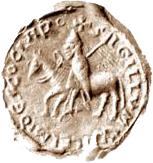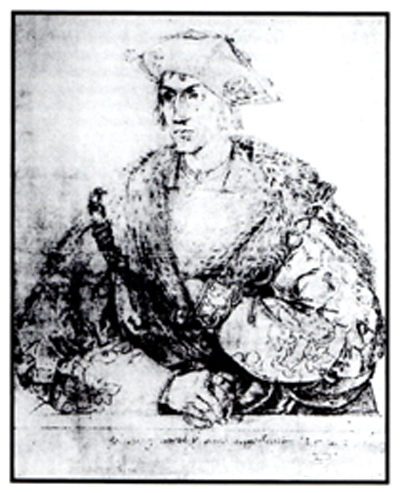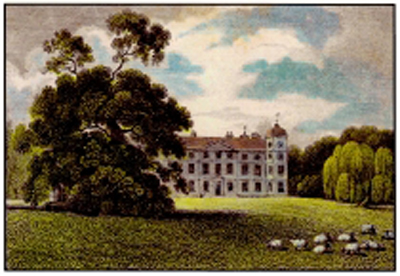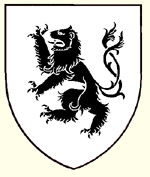The Morley family
Ultimately, the Morley family was the principal beneficiary of the lands and honours acquired by the St. Clairs, Lanvaleis, Burghs, FitzWalters and Marshals. Marriages brought new wealth to each of the families, adding to inheritances and grants from successive kings, but this wealth could just as easily be lost through seizures or payments of debts. The St. Clairs’ estates derived initially from those of Eudo dapifer, steward to king William I, William Rufus and Henry I. Eudo’s father Hubert de Rie had long been a supporter of William, duke of Normandy, and his sons all received lands in England after the conquest. Hubert and Richard de Saint Clair gained little, possibly because their father, brother of Hubert de Rie, lost his life fighting the duke at the battle of Val-es-Dunes in 1047. But Hamo and William de Saint Clair were more fortunate. They were granted a number of Eudo’s estates by Henry I after Eudo died in 1120, and were able to hold on to them during king Stephen’s chaotic reign.
With the accession of Henry II, their manors passed to William de Lanvalei on his marriage to Gunnore de St. Clair. William was granted Henherst in Kent and his brother Ralph the fee-farm of Shaftesbury in Dorset. By the time William (III) de Lanvalei had joined the Magna Carta barons, he had been able to purchase the governorship of Colchester castle from king John. By 1227, Hawise de Lanvalei had married John de Burgh, the beneficiary not only of Hubert de Burgh’s hereditary estates, but also those of Margaret of Scotland, Hubert’s widow. Devorguilla de Burgh married Robert FitzWalter, bringing with her that portion of the combined estates of the St. Clairs, Lanvaleis and Burghs she held as one of three sisters.
Robert FitzWalter, though, was less successful at holding onto his lands, yet his granddaughter Christian FitzWalter still brought a significant estate to William Marshal, and within one generation all these passed to Robert de Morley when he married their daughter Hawise, Baroness Marshal.
The Morleys had only held their barony since 1299, Robert being the 2nd Lord Morley. Through Hawise, they added the barony of Marshal, and Monteagle in 1585. However, all three baronies ceased to exist in 1697. In the century or so after Hawise had married Robert de Morley, the male line failed, and their titles passed first to the Lovel family with the marriage of Alianore de Morley to Sir Henry Lovel about 1464, and then to the Parker family.
An example of the fortunes of one manor is that of Walkern in Hertfordshire. This manor was granted to Hamon de St. Clair in the 1120s by king Henry I. It passed to the Lanvaleis who held it when William (III) de Lanvalei joined the barons in 1215. His marble effigy still survives in the parish church. John de Burgh held it by right of Hawise de Lanvalei his wife, William’s daughter. Their son John left three daughters as co-heirs and Walkern was held by Devorguille in her right as wife of Robert FitzWalter. Christian FitzWalter succeeded and William Marshall inherited it. It passed to John Marshal of Hingham, Norfolk, but because he had no male heir, his sister Hawise succeeded. She married Robert de Morley before 1316 and until 1530 the manor remained in the hands of their Morley descendants, the Lovels and then the Parkers, after which it was sold to Sir William Capel Kt., Mayor of London, by Alice Parker and her husband Sir Edward Howard Kt.
The account rolls of Robert de Morley for Walkern in 1324-25 have survived, and the following is part of an entry written in Norman-French:
Robert de Morle to the servant and steward of Walkerne We order that you levy 24s. from the wheat or corn that you have and that you take it to our steward And you pay the 24s. abovesaid to Richard Mayner taverner de le Newemarkat in full satisfaction of a debt we owe him…
Hingham in Norfolk is another manor. King Stephen first granted this manor to William de Chesney and then in an exchange to Henry de Rie, the son of Hubert de Rie, castellan of Norwich, when it became the caput of the barony of Rie. King John granted it to John “the Marshal” in 1202, and confirmed it in 1210 after John’s marriage to Aveline, the daughter and coheir of Hubert de Rie, Baron of Rie in Norfolk. Isabell, Aveline’s sister, married Roger de Cressi, and between John and Roger, they held 35 knights’ fees of the barony of Rie. John retained Hingham and subsequently the whole barony descended to William his brother. John Marshall obtained the barony in 1279, but died in 1282 leaving his young son William his heir. When William came of age he was summoned to aid king Edward I against the Scots and in 1300 was summoned to Parliament as a Baron. On his death in 1314 at the battle of Bannockburn, his son John inherited the barony of Rie. He died in 1316, and Hawise, who had married Robert de Morley, was the sole heir.
In 1402, Thomas de Morley, 4th Lord Morley and 5th Lord Marshal, was found by inquisition to hold the manors of Hingham, Morley, Swanton, Buxton, Hockering, and Alsby, with the hundreds of Forehoe and Eynsford in Norfolk, Great Hallingbury in Essex, Walkern in Hertfordshire, and Aslakby in Lincolnshire.
| 1 | 2 | 3 | 4 | 5 | 6 | 7 | 8 | 9 | 10 | 11 | 12 | 13 | 14 | generations | |
| William de Morley (-c.1302), Baron Morley 29 Dec 1299, | |||||||||||||||
| m. (2) before Oct 1295, Cicely ——- (-after 1316) | |||||||||||||||
| m. (1) Isabel, dau. of Robert de Mohaut and Joan de Mowbray | |||||||||||||||
| Robert (-1360), 2nd Lord [Baron] Morley, | |||||||||||||||
| m. (2) before Sep 1334, Joan (-1358), dau. of Sir Piers de Tyes | |||||||||||||||
| m. (1) before 1316, Hawise (-before 1327), in her own right Baroness Marshal 1316, | |||||||||||||||
| dau. of William Marshal, Lord [Baron] Marshal, and Christian FitzWalter | |||||||||||||||
| William (1319-1379), 3rd Lord Morley, 4th Lord Marshal | |||||||||||||||
| m. before 1344/5, Cicely (-1386), dau. of Thomas Bardolphe, 2nd Lord | |||||||||||||||
| Bardolphe, and Agnes de Grandison | |||||||||||||||
| Thomas (c.1354-1416), 4th Lord Morley, 5th Lord Marshal, KG c.1411 | |||||||||||||||
| m. (2) before Oct 1390, Anne, dau. of Edward le Despenser, 1st Lord | |||||||||||||||
| le Dispenser, and Elizabeth de Burghersh | |||||||||||||||
| m. (1) before Apr 1374, Joan (-1384), dau. of Sir Hugh Hastings and | |||||||||||||||
| Margaret de Everingham | |||||||||||||||
| Robert (c.1375-1403) m. before Aug 1394, Isabel Molines | |||||||||||||||
| Thomas, 5th Lord Morley, 6th Lord Marshal (c.1393-1435) | |||||||||||||||
| unknown wife or mistress | |||||||||||||||
| Elizabeth m. Sir John Arundell, son of John Arundell | |||||||||||||||
| and Margaret Burgersh | |||||||||||||||
| Anne m. settlement Mar 1469, Sir James Tyrell | |||||||||||||||
| m. before Feb 1402/3, Isabel (-1466/7), | |||||||||||||||
| dau. of Michael de la Pole, 2nd Earl of Suffolk, and | |||||||||||||||
| Katherine de Stafford | |||||||||||||||
| Ann m. after Apr 1434, John Hastings, son of | |||||||||||||||
| Sir Edward Hastings and Muriel de Dinham | |||||||||||||||
| Sir Hugh Hastings (1437-1488) | |||||||||||||||
| m. before 12 Apr 1455, Anne, dau. of | |||||||||||||||
| Sir William Gascoigne, issue | |||||||||||||||
| Elizabeth Hastings (1439-) | |||||||||||||||
| m. Sir Robert, son of Sir Thomas Hyllyard and | |||||||||||||||
| Katherine de la Haye | |||||||||||||||
| Isabel Hastings (1444-1490) | |||||||||||||||
| m. Thomas, son of William Boseuille and | |||||||||||||||
| Maude FitzWilliam | |||||||||||||||
| Edmond Hastings (1447-1487) | |||||||||||||||
| m. 1481, Eleanor, dau. of Sir Edward Woodhouse | |||||||||||||||
| Robert Hastings (1450-1505) | |||||||||||||||
| m. Elizabeth, dau. of William Thwaites and | |||||||||||||||
| Margery Mauleverer, issue | |||||||||||||||
| Meryll Hastings (1453-) m. 1473, Sir Henry Pierrepoint | |||||||||||||||
| Robert (1418-1443), 6th Lord Morley, 7th Lord Marshal, | |||||||||||||||
| m. Elizabeth, dau. of William de Ros, 6th Lord Ros, | |||||||||||||||
| and Margaret Fitzalan | |||||||||||||||
| Alianore Morley (1442-1476), in her own right | |||||||||||||||
| Lady Morley, Lady Marshal | |||||||||||||||
| m. before Jan 1464/5, Sir William Lovel (-1476), | |||||||||||||||
| by right of his wife 7th Lord Morley, 8th Lord Marshal | |||||||||||||||
| son of William,7th Lord Lovel of Tichmersh, and | |||||||||||||||
| Alice Deincourt, in her own right Lady Deincourt | |||||||||||||||
| Henry Lovel (1466-1489), 8th Lord Morley, | |||||||||||||||
| 9th Lord Marshal | |||||||||||||||
| m. Elizabeth (-c.1490), dau. of John de La Pole, | |||||||||||||||
| 2nd Duke of Suffolk, and | |||||||||||||||
| Elizabeth Plantagenet. No issue | |||||||||||||||
| Alice Lovel (c.1467-1518), 9th Lady Morley, | |||||||||||||||
| in her own right 10th Lady Marshall | |||||||||||||||
| m. (2) before Jan 1505/6, Lord Edward Howard, | |||||||||||||||
| Lord High Admiral of England 1513, | |||||||||||||||
| son of Thomas Howard, 2nd Duke of Norfolk, | |||||||||||||||
| and Elizabeth Bourchier | |||||||||||||||
| m. (1) before 1486, Sir William Parker, | |||||||||||||||
| Standard Bearer to King Richard III, | |||||||||||||||
| Henry Parker (c.1486-1556), | |||||||||||||||
| 10th Lord Morley, 11th Lord Marshal | |||||||||||||||
| Henry Parker (1531-1577), | |||||||||||||||
| 11th Lord Morley, 12th Lord Marshal | |||||||||||||||
| Edward Parker (c.1550-1618), | |||||||||||||||
| 12th Lord Morley, 13th Lord Marshal | |||||||||||||||
| William Parker (c.1575-1622), | |||||||||||||||
| 13th Lord Morley, | |||||||||||||||
| 1st Lord Monteagle 1585, | |||||||||||||||
| 14th Lord Marshal | |||||||||||||||
| Henry Parker (c.1600-1655), | |||||||||||||||
| 14th Lord Morley, | |||||||||||||||
| 2nd Lord Monteagle, | |||||||||||||||
| 15th Lord Marshal | |||||||||||||||
| Thomas Parker | |||||||||||||||
| (c.1636-1697), | |||||||||||||||
| 15th Lord Morley, | |||||||||||||||
| 3rd Lord Monteagle, | |||||||||||||||
| 16th Lord Marshal | |||||||||||||||
| Baronies of Morley, Marshal and Monteagle abeyant 1697 | |||||||||||||||



